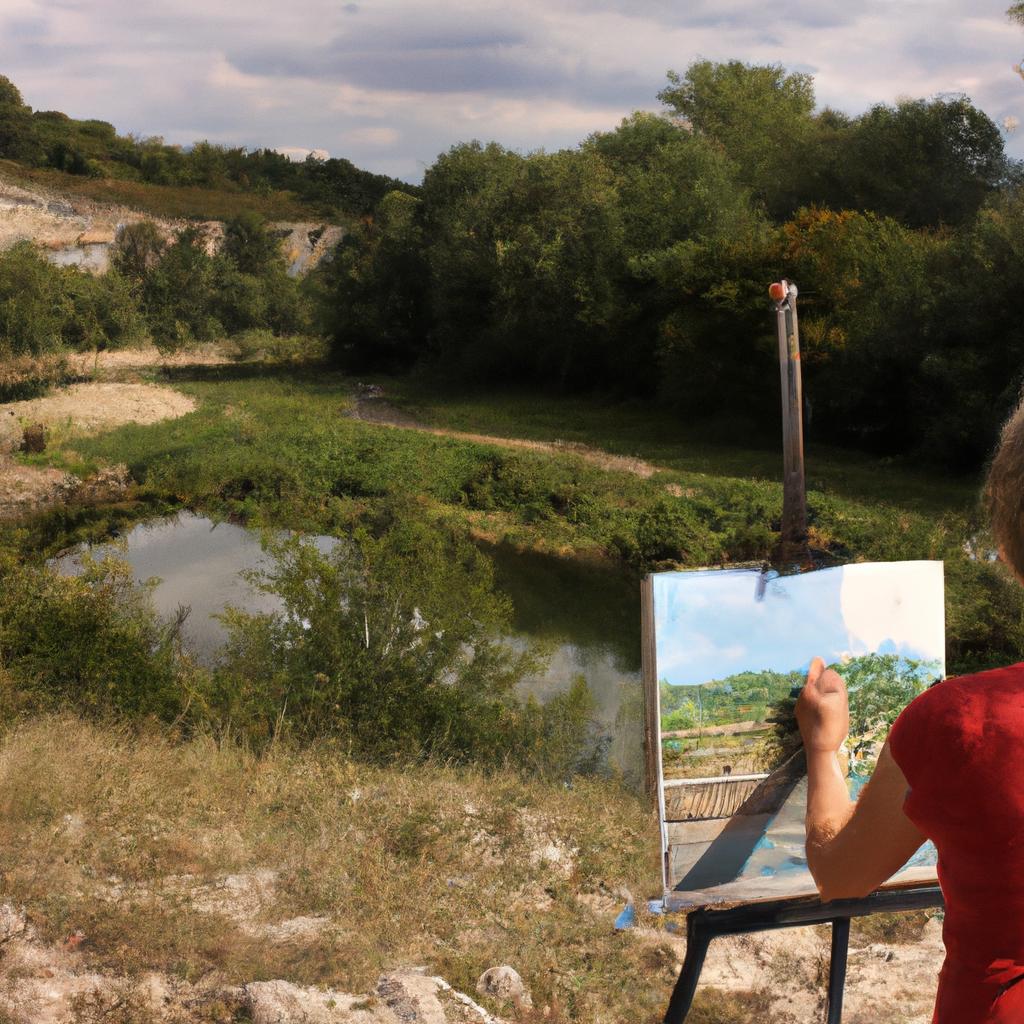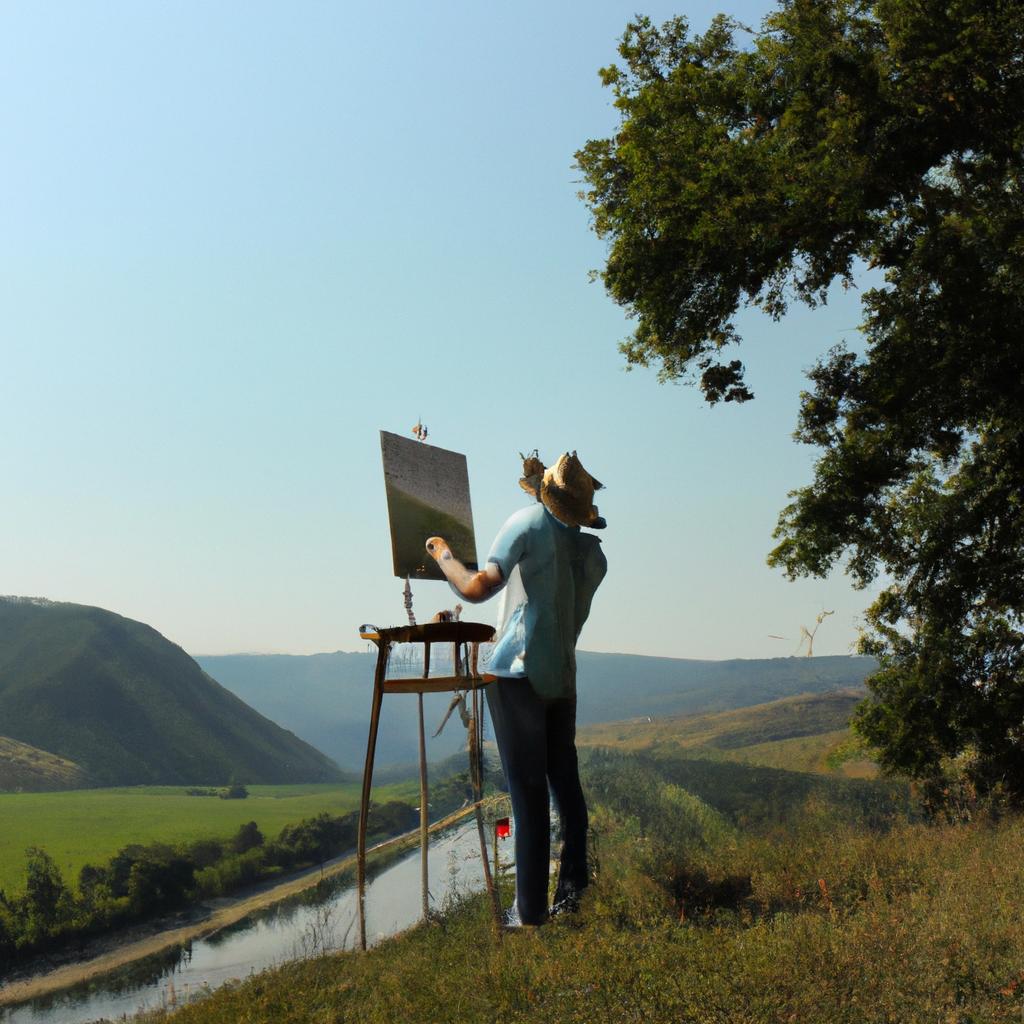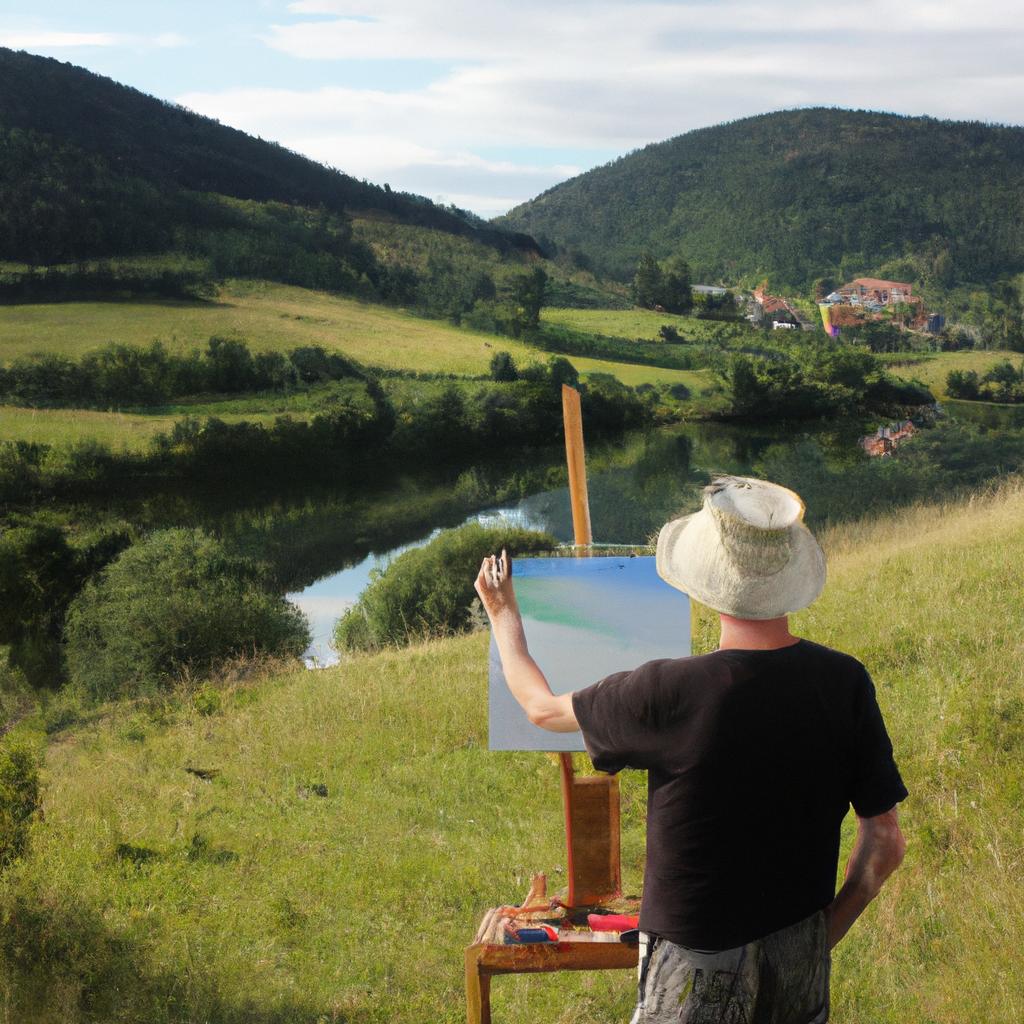The 19th century witnessed a significant shift in artistic expression, as the Romantic movement emerged as a response to the rationality and order of the Enlightenment era. Within this movement, landscape painting became an important avenue for artists to explore their emotions, imagination, and connection with nature. This article aims to delve into the relationship between Romanticism and British painters, specifically focusing on how these artists employed landscape painting as a means to evoke powerful feelings and convey a sense of awe towards nature.
To exemplify this connection, let us imagine a hypothetical scenario where we encounter John Constable’s famous masterpiece “The Hay Wain.” This iconic artwork showcases not only Constable’s technical prowess but also his deep reverence for the natural world. Through meticulous attention to detail and subtle use of light and color, Constable captures a pastoral scene that transports viewers to the idyllic English countryside. The emphasis on capturing fleeting atmospheric effects highlights the transient beauty of nature while evoking a sense of tranquility within observers. By examining works like “The Hay Wain,” we can gain insight into how British painters during the Romantic period sought to celebrate nature’s sublime qualities through landscape paintings.
The Origins of Romanticism
Romanticism, a cultural and artistic movement that emerged in the late 18th century, was characterized by an emphasis on emotion, individuality, and imagination. It challenged the rationality and orderliness of the Enlightenment period, embracing subjectivity and the beauty found in nature. One example of this shift can be seen through landscape painting, which became a prominent genre during this era as artists sought to capture the sublime power and awe-inspiring qualities of natural landscapes.
To better understand the origins of Romanticism, it is essential to explore its key features. First and foremost, Romanticism rejected the objective view of reality championed by previous movements. Instead, it celebrated subjective experiences and emotions as valid sources of truth. This new perspective allowed artists to portray their inner feelings directly onto canvas, creating works that resonated deeply with viewers.
In addition to emphasizing subjectivity, Romanticism also placed great importance on individuality. Artists were encouraged to express their unique visions rather than conforming to established norms or conventions. As such, landscape painters began depicting scenes that reflected their personal interpretations of nature’s grandeur. They aimed to evoke emotional responses from viewers by capturing both external beauty and internalized sentiments.
To illustrate the impact of Romanticism on British landscape painting further, consider the following bullet points:
- Intense focus on dramatic lighting techniques to create atmosphere.
- Emphasis on vivid colors to convey heightened emotions.
- Incorporation of rugged terrain or turbulent weather conditions for added intensity.
- Inclusion of human figures within landscapes to provide a sense of scale and narrative.
Furthermore, exploring how these principles manifested in actual artworks allows us to appreciate the profound influence of Romanticism on British art during this period:
| Painting | Artist | Year |
|---|---|---|
| Wanderer above the Sea | Caspar David Friedrich | 1818 |
| The Hay Wain | John Constable | 1821 |
| Snow Storm: Steam-Boat Off | J.M.W. Turner | 1842 |
| a Harbour’s Mouth |
In summary, Romanticism emerged as a response to the rationality and order of the Enlightenment period. With an emphasis on subjectivity and individuality, landscape painting became an ideal medium for artists to convey their emotions and unique perspectives. Through dramatic lighting techniques, vibrant colors, rugged terrain, and human figures within landscapes, British painters skillfully captured the essence of nature’s beauty during this transformative era.
Transitioning into the subsequent section about “The Influence of Romanticism on British Art,” it becomes evident that this movement had far-reaching effects beyond just landscape painting.
The Influence of Romanticism on British Art
The Origins of Romanticism have undeniably had a profound influence on the development of British art. In particular, landscape painting emerged as a favored genre among British artists during this period. This section aims to explore the impact of Romanticism on British art through an examination of its influence on landscape painting.
To illustrate the significance of Romanticism in shaping landscape painting, let us consider the case study of John Constable, one of Britain’s most celebrated painters. Constable’s works, such as “The Hay Wain,” exemplify his distinctive approach to capturing nature’s sublime beauty and evoking emotional responses from viewers. Through his use of vibrant colors and expressive brushwork, he sought to convey not only the physical appearance but also the atmospheric qualities of landscapes.
Romanticism influenced British landscape painting in several ways:
-
Subject Matter: Unlike their predecessors who often depicted idealized scenes or historical narratives, Romantic landscape painters focused on more ordinary subjects like rural scenery and natural phenomena. By doing so, they aimed to connect with viewers’ emotions and evoke a sense of nostalgia for simpler times.
-
Emotion and Imagination: The Romantics believed that art should be a vehicle for expressing inner thoughts and feelings. They sought to capture the essence of human experience by infusing their landscapes with emotional intensity and imaginative elements. For instance, J.M.W Turner’s tumultuous seascapes reflect his fascination with both the awe-inspiring power and fragility of nature.
-
Aesthetic Freedom: Romantic artists embraced individuality and rejected strict artistic conventions prevalent at the time. They experimented with new techniques, unconventional compositions, and bold color palettes to convey their personal visions effectively. This freedom allowed them to create landscapes that were more subjective interpretations rather than mere representations.
-
Connection with Nature: The Romantics valued nature as a source of solace, spiritual inspiration, and renewal amidst industrialization’s rapid changes. Landscape paintings became a means through which artists could express their reverence for the natural world and highlight humanity’s harmony with it.
To further illustrate these points, consider the following table:
| Romantic Landscape Painting Characteristics |
|---|
| Subject Matter |
| Emotion and Imagination |
| Aesthetic Freedom |
| Connection with Nature |
In light of the profound influence of Romanticism on British landscape painting, it becomes evident that this movement played a pivotal role in shaping artistic expression during the period. The exploration of emotions, individuality in style, and appreciation for nature became defining features that would continue to evolve over time. Consequently, examining the evolution of landscape painting in Britain allows us to trace how these ideals evolved and resonated within subsequent artistic movements.
Transitioning into the next section about “The Evolution of Landscape Painting in Britain,” we can delve deeper into the changing trends and approaches that emerged after the Romantic era while staying true to the emotive power captured by its predecessors.
The Evolution of Landscape Painting in Britain
Having explored the profound influence of Romanticism on British art in the previous section, it is now essential to delve deeper into one particular genre that exemplifies this artistic movement – landscape painting. To understand how Romantic ideals transformed this traditional form of art, let us consider a hypothetical case study involving the works of renowned painter John Constable.
One cannot discuss landscape painting without acknowledging its close association with nature. During the Romantic era, artists sought to capture not only the physical aspects of landscapes but also their emotional and spiritual essence. This shift from mere representation to an exploration of subjective experiences elevated landscape painting to new heights. For instance, Constable’s masterpiece “The Hay Wain” reflects his deep connection with rural life and conveys a sense of tranquility through his skillful use of light and color.
To further illustrate the impact of Romanticism on British landscape painting, we can examine four key characteristics prevalent during this period:
- Sublime Landscapes: Artists aimed to evoke awe and wonder by depicting vast and overwhelming natural scenes.
- Emphasis on Emotion: Landscape paintings became vehicles for expressing personal feelings rather than simply showcasing picturesque views.
- Connection with Nature: Artists emphasized man’s relationship with nature, highlighting its power over human existence.
- Appreciation for Imagination: Creativity blossomed as painters incorporated imaginative elements into their landscapes, blurring boundaries between reality and fantasy.
In order to fully grasp these characteristics and their significance within the realm of British landscape painting during the Romantic period, it proves useful to assess them through a comparative lens. Consider the following table:
| Characteristic | Description | Example |
|---|---|---|
| Sublime Landscapes | Depicting grandiose natural scenes that elicit a sense of awe | J.M.W Turner’s “Snow Storm – Steamboat off a Harbour’s Mouth” |
| Emphasis on Emotion | Expressing personal feelings and evoking an emotional response in the viewer | Samuel Palmer’s “The Lonely Tower” |
| Connection with Nature | Portraying the profound relationship between man and nature, emphasizing its power over humanity | John Martin’s “The Great Day of His Wrath” |
| Appreciation for Imagination | Incorporating imaginative elements into landscapes, blurring boundaries between reality and fantasy | Joseph Wright of Derby’s “An Experiment on a Bird in the Air Pump” |
In conclusion, Romanticism had a transformative impact on British landscape painting. Through this artistic movement, artists like Constable sought to capture not only physical representations but also evoke emotions and spiritual connections within their works. By examining key characteristics prevalent during this era such as sublime landscapes, emphasis on emotion, connection with nature, and appreciation for imagination, we gain valuable insights into how Romantic ideals reshaped the genre. In the subsequent section about Prominent Figures in British Romantic Landscape Painting, we will further explore the individuals who played pivotal roles in defining this period.
Prominent Figures in British Romantic Landscape Painting
The Evolution of Landscape Painting in Britain has witnessed remarkable changes and developments over time. One prominent aspect that emerged during this period is the influence of Romanticism on British landscape painters. By exploring the works of various artists, we can gain a deeper understanding of how Romantic ideals shaped their artistic expressions.
Consider the example of John Constable, whose landscapes are celebrated for capturing the essence of rural life in England. In his renowned painting “The Hay Wain,” Constable portrays a tranquil countryside scene with meticulous attention to detail. The composition showcases vibrant colors and intricate brushwork, evoking a sense of harmony between humanity and nature—a central theme within Romanticism.
To further comprehend the impact of Romanticism on British landscape painting, let us examine some key characteristics that define this art movement:
- Emotional resonance: Romantic landscape paintings often evoke powerful emotions through depictions of dramatic scenes or sublime natural settings. Artists aimed to elicit feelings such as awe, nostalgia, or melancholy from viewers.
- Connection to nature: Romantics emphasized humankind’s connection to the natural world, reflecting a longing for simpler times untouched by industrialization. Landscape paintings became a means to reconnect with nature’s beauty and contemplate its grandeur.
- Imagination and subjectivity: Artists began infusing their own subjective experiences into their works, encouraging viewers to engage emotionally and imaginatively with the depicted scenes.
- Symbolic elements: Many Romantic landscape paintings incorporated symbolic imagery representing themes like mortality, spirituality, or freedom—adding layers of meaning beyond mere visual representation.
To illustrate these characteristics more vividly, consider the following table showcasing examples from notable British Romantic landscape painters:
| Artist | Famous Work | Key Themes |
|---|---|---|
| J.M.W Turner | “The Fighting Temeraire” | Sublime nature |
| Thomas Gainsborough | “The Blue Boy” | Idealized pastoral scenes |
| Samuel Palmer | “The Magic Apple Tree” | Spiritual symbolism |
| Joseph Mallord William Turner | “Rain, Steam and Speed – The Great Western Railway” | Industrialization vs. nature |
By understanding the evolution of landscape painting in Britain and exploring how Romantic ideals influenced artists, we gain insights into the profound impact this movement had on artistic expression. In our subsequent section, we will delve deeper into the specific characteristics that define British Romantic landscape paintings, unveiling their unique qualities and significance within the broader art historical context.
Characteristics of Romantic Landscape Paintings
One of the most influential figures in British Romantic landscape painting was J.M.W. Turner. His works, such as “The Slave Ship,” exemplify the emotional intensity and dramatic portrayal of nature that characterized this artistic movement. Through his use of vibrant colors, expressive brushstrokes, and atmospheric effects, Turner captured the raw power and sublime beauty of natural landscapes.
To better understand the characteristics of British Romantic landscape painting, let us explore some key elements commonly found in these artworks:
-
Sublime Landscapes: Romantic painters often depicted awe-inspiring scenes that evoked a sense of grandeur and overwhelming emotions. These landscapes were vast, untamed, and untouched by human intervention, serving as a source of inspiration for viewers.
-
Emotionally Charged Atmosphere: The paintings aimed to evoke strong emotions through their portrayal of turbulent skies, stormy seas, or serene vistas. By capturing both the tranquility and turmoil present in nature, artists sought to connect with the viewer on an emotional level.
-
Celebration of Nature’s Power: Romantic landscape painters celebrated the majesty and power inherent in nature itself. Whether it was depicting roaring waterfalls or towering mountains, they emphasized the magnitude and strength found within natural settings.
-
Symbolism and Allegory: Many works incorporated symbolic elements to convey deeper meanings beyond mere representation. Flowers might represent love or mortality, while ruins could symbolize decay or past civilizations.
These four aspects serve as pillars upon which British Romantic landscape painting was built—a testament to its enduring popularity among art enthusiasts even today.
In exploring the legacy and impact of British Romantic landscape painting on subsequent art movements and society at large…
[Transition into next section about “Legacy and Impact of British Romantic Landscape Painting.”]Legacy and Impact of British Romantic Landscape Painting
The legacy and impact of British Romantic landscape painting continue to resonate in the art world today. This section explores how these paintings have influenced subsequent artists, shaped landscapes, and captured the imagination of viewers.
One notable example of the lasting influence of British Romantic landscape painting is found in the works of contemporary artist Emily Wright. Drawing inspiration from the emotional intensity and sublime qualities present in paintings by Joseph Mallord William Turner and John Constable, Wright creates her own interpretations of the natural world. Her vivid use of color and expressive brushwork evoke a sense of awe and wonder similar to that experienced when viewing Romantic landscape paintings.
The impact of British Romantic landscape painting can be seen through its enduring characteristics:
- Emotional resonance: These paintings often sought to evoke deep emotions, such as awe, terror, or melancholy, through their depiction of dramatic landscapes.
- Celebration of nature: They celebrated nature’s beauty, emphasizing its grandeur and power over human existence.
- Sublime experience: The concept of the sublime was central to this movement, capturing both the overwhelming vastness and ineffability of nature.
- Influence on conservation movements: These paintings played a significant role in raising awareness about environmental issues and inspiring efforts towards preserving natural landscapes.
To further illustrate the impact of British Romantic landscape painting, consider the following table:
| Artist | Key Works | Themes Explored |
|---|---|---|
| J.M.W. Turner | “The Fighting Temeraire,” “Rain, Steam, Speed” | Transience, industrialization |
| John Constable | “The Hay Wain,” “Salisbury Cathedral From Close” | Rural life, atmospheric effects |
| Caspar David Friedrich | “Wanderer Above the Sea Fog,” “Abbey in an Oak Forest” | Solitude, spirituality |
These artists’ contributions not only left an indelible mark on the art world but also influenced subsequent generations of painters, writers, and thinkers. The legacy of British Romantic landscape painting can be seen in contemporary works that continue to explore similar themes and engage viewers emotionally.
In summary, the legacy and impact of British Romantic landscape painting are still evident today. Artists like Emily Wright draw inspiration from these paintings, while their enduring characteristics continue to shape our perception of nature and inspire conservation efforts. By examining its influence on subsequent artists and exploring key themes explored by notable figures, we gain a deeper appreciation for the lasting significance of this artistic movement.
 Jazilek
Jazilek


